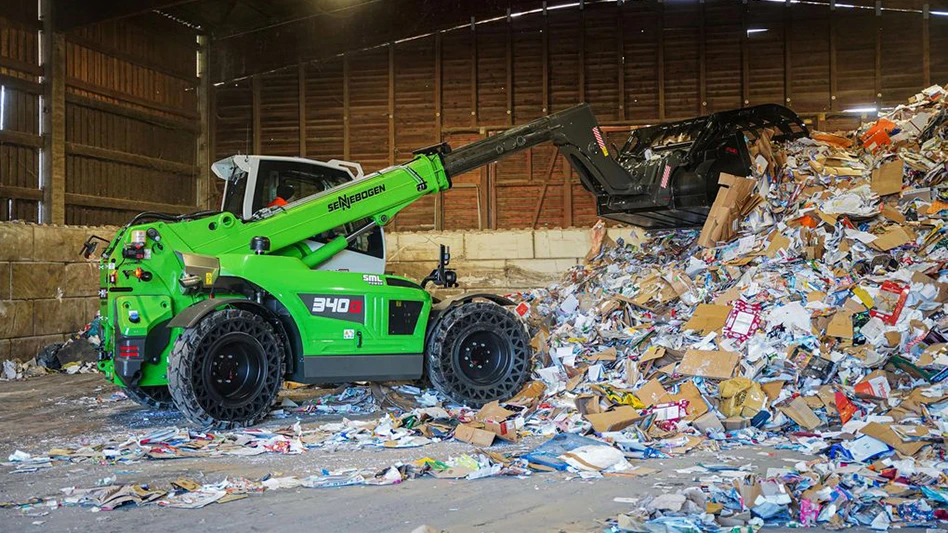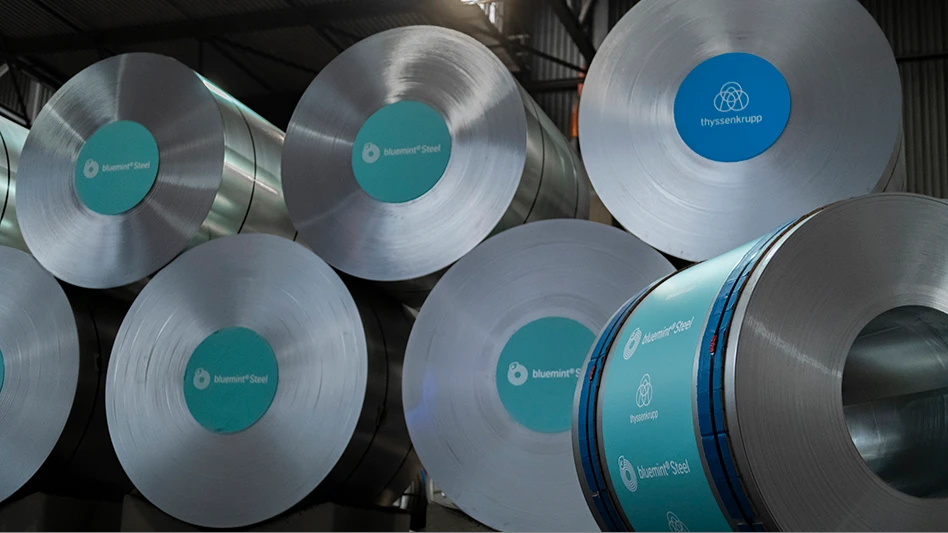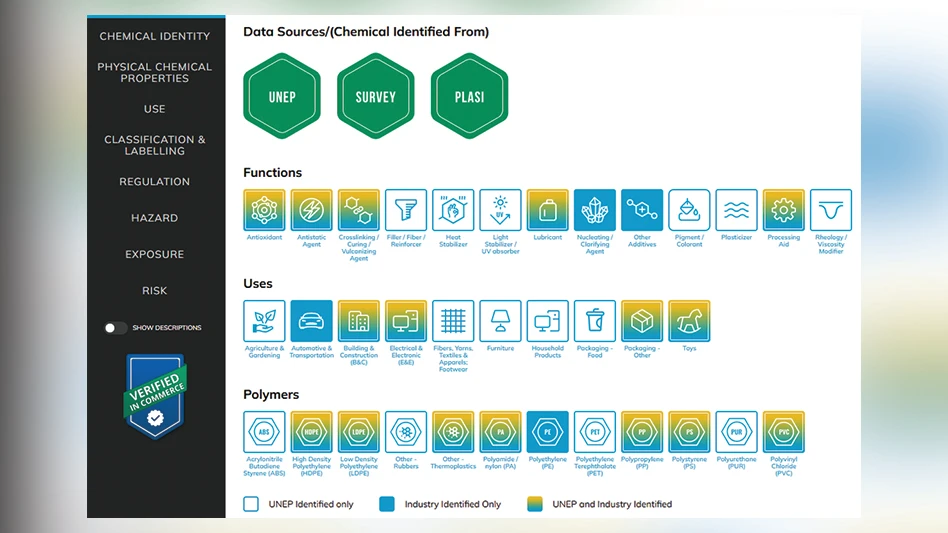 When customers approach Mikael Keremes about buying a material handler, Keremes will usually ask what sounds like a simple question: "What are you planning to do with it?"
When customers approach Mikael Keremes about buying a material handler, Keremes will usually ask what sounds like a simple question: "What are you planning to do with it?"
"We are going to load scrap," is the usual reply.
However, the vice president of sales for the western Pennsylvania region of Cleveland-based equipment dealer Gibson Machinery LLC says the answer is much more complicated.
For Keremes to make the best recommendation, he will need to know what is being loaded, how many tons per day are being shipped out of the yard, what material is being moved and the layout of the yard.
"All those questions make a difference in the size machine they are looking for," Keremes explains.
Other factors to consider, according to Jeff Wilson of Charlotte, N.C.-based Liebherr dealer Republic Crane, are reach, material density, ideal operator eye level and required safety measures.
"These are just a few items to address when the purchasing process begins," Wilson says. "Material will determine whether the use of a grapple or magnet is needed."
 Smaller feeder yards can get away with smaller material handlers. However, if the yard has an auto shredder, a higher capacity machine may be necessary. While a smaller machine might offer more mobility and transportability among yards and a lower operating cost per hour, it may not be able to handle the volume that a larger, more powerful machine can or provide the same stacking height.
Smaller feeder yards can get away with smaller material handlers. However, if the yard has an auto shredder, a higher capacity machine may be necessary. While a smaller machine might offer more mobility and transportability among yards and a lower operating cost per hour, it may not be able to handle the volume that a larger, more powerful machine can or provide the same stacking height.
"There are situations where mobility is more important, and there are situations where weight class is vital due to feeding a shredder or a large shear," Wilson says.
Steve Brezinski of Terex Fuchs, Southaven, Miss., says some yards use a combination of larger and smaller material handlers. The larger material handlers will do the heavy lifting, while the smaller machines will handle material brought in by peddler traffic or engage in yard cleanup with a magnet.
Expansion goals should be taken into consideration in the machine decision as well. "Depending on what their expansion goals are, they may want to buy a bigger machine," Brezinski says, adding that yards should go with a larger material handler if they plan to add an auto shredder in the future.
.jpg) |
Weighting the Options
Size is not the only aspect a recycler will have to consider when selecting a material handler. From automation to safety to power source, many options are available. Wilson says every material handler should have certain features, including a boom and stick and load-holding valves, a safety lever and a rear-view safety camera. The material handler also should be "generator ready," Wilson says.
Brezinski says Terex offers generators as a standard feature for running electro-magnets. Terex also offers a "quick attach" system, which Brezinski describes as a hanger at the end of the stick. This allows operators to change between a grapple and a magnet without having to remove the pin at the end of the stick.
"Other features depend on the application," he adds.
A straight boom and stick are typically standard on machines, but options are available for specialized applications. For example, a yard that is loading barges may opt for a bent boom on a material handler, which will allow for a lower reach.
Recyclers using a material handler to sort material at a transfer station may require an optional stick with a cylinder at the end of it for greater flexibility and motion.
One aspect Keremes says he appreciates about the Sennebogen machines he sells is that many critical components are made in the U.S. This is important, he says, because if the dealer or manufacturer does not have a part, they easily can look through common distribution channels to find what a customer needs.
On the Ground
Determining which platform to go with on a material handler has a lot to do with terrain and how much movement is necessary. Dealers and manufacturers say wheeled material handlers are more popular than the track-mounted models for recycling, especially since yards are more commonly paved with concrete.
Brezinski says tracked machines are useful in dirt or mud. They also can be useful in applications that tend to be largely stationary.
In addition to wheeled and track-mounted material handlers, pedestal-mounted machines also are finding a place in scrap yards and other recycling facilities. Keremes says fuel savings are a key reason why recyclers are choosing electric models. While the initial cost for a pedestal-mounted material handler may be 20 to 25 percent more than wheeled or tracked models, Keremes contends, "The fuel savings will pay for the difference in two to three years tops."
 Other benefits to pedestal-mounted material handlers can include reduced maintenance and increased efficiency. With no internal combustion engine, they also can run longer and stay cooler than diesel-powered machines. They also last longer, Keremes says. A typical diesel-powered material handler can run about 20,000 to 25,000 hours before it needs to be rebuilt, while Keremes estimates an electric machine can run 30,000 to 40,000 hours. On-site emissions also are eliminated with electric units.
Other benefits to pedestal-mounted material handlers can include reduced maintenance and increased efficiency. With no internal combustion engine, they also can run longer and stay cooler than diesel-powered machines. They also last longer, Keremes says. A typical diesel-powered material handler can run about 20,000 to 25,000 hours before it needs to be rebuilt, while Keremes estimates an electric machine can run 30,000 to 40,000 hours. On-site emissions also are eliminated with electric units.
With so much to consider when buying a material handler, talking to a salesperson is important, Keremes says. "Good sales representatives should know the products, what they can handle and what they are capable of doing. They really need to narrow down what it is the customer wants to do," he says.
|
An Inside Job Not all material handlers are built for the big jobs. Smaller material handlers that can move material indoors or at transfer stations are also available. One example is the MHL320 D material handler from Terex Fuchs, Southaven, Miss. The machine can be used for processing material, including metals and municipal solid waste (MSW). Operators also can choose the electric-powered MHL820 D from Terex for use indoors, which has an electric motor configuration and is offered as a wheeled unit with a cable line length specified by the customer. The emissions-free electric motor model offers lower operating costs and reduced maintenance and service costs compared with the standard MHL320 D, Terex says. The upper carriage of the MHL320 D also can be pedestal mounted as a stationary option. Beyond its standard 31.2-foot reach, the MHL320 D offers a variety of boom and stick combinations with reaches ranging from 26.9 to 34.1 feet. Two universal stick configurations incorporate a stick-mounted hydraulic cylinder in the design, which allows for up-and-down tilting as well as for left-and-right slewing of the attachment. The MHL320 D with universal stick is designed to offer material sorting flexibility and efficiency, according to Terex. More information is available at www.terex.com. |
The author is associate editor of Recycling Today and can be reached at ksmith@gie.net.

Explore the November 2011 Issue
Check out more from this issue and find your next story to read.
Latest from Recycling Today
- Harsco brands slag-content asphalt as SteelPhalt
- ArcelorMittal puts French EAF conversions on hold
- Associations ask for effective EPR to drive textile circularity in Europe
- GESA report claims 72 countries recycled EPS in 2023
- Report: Saica exploring recycled paper mill project in Dayton, Ohio
- Hydro’s Alumetal to meet 15 percent of its energy demands through solar
- CSA Group publishes standard defining plastics recycling in Canada
- Second Cyclyx Circularity Center to be located near Fort Worth, Texas





